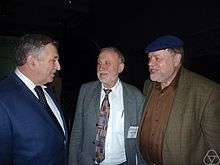Sylvain Cappell
| Sylvain Cappell | |
|---|---|
 Sylvain Cappell (right) | |
| Born |
1946 (age 71–72) Brussels, Belgium |
| Nationality | Belgian American |
| Alma mater |
Princeton University Columbia University |
| Awards |
AMS Distinguished Public Service Award (2018) Guggenheim Fellowship (1989–90) Sloan Fellowship (1971–72) |
| Scientific career | |
| Fields | Mathematics |
| Institutions | New York University |
| Doctoral advisor | William Browder |
| Doctoral students |
Shmuel Weinberger Markus Banagl |
Sylvain Edward Cappell (born 1946), a Belgian American mathematician and former student of William Browder at Princeton University, is a topologist who has spent most of his career at the Courant Institute of Mathematical Sciences at NYU, where he is now the Silver Professor of Mathematics.
He was born in Brussels, Belgium and immigrated with his parents to New York City in 1950 and grew up largely in this city.[1] In 1963, as a senior at the Bronx High School of Science, he won first place in the Westinghouse Science Talent Search for his work on "The Theory of Semi-cyclical Groups with Special Reference to Non-Aristotelian Logic." He is best known for his "codimension one splitting theorem",[2] which is a standard tool in high-dimensional geometric topology, and a number of important results proven with his collaborator Julius Shaneson (now at the University of Pennsylvania). Their work includes many results in knot theory (and broad generalizations of that subject)[3] and aspects of low-dimensional topology. They gave the first nontrivial examples of topological conjugacy of linear transformations,[4] which led to a flowering of research on the topological study of spaces with singularities.[5]
More recently, they combined their understanding of singularities, first to lattice point counting in polytopes, then to Euler-Maclaurin type summation formulae,[6] and most recently to counting lattice points in the circle.[7] This last problem is a classical one, initiated by Gauss, and the paper is still being vetted by experts.
In 2012 he became a fellow of the American Mathematical Society.[8] Cappell was elected and served as a vice president of the AMS for the term of February 2010 through January 2013.[9][10]
References
- ↑ http://nychold.org/quest-0211.html#cappell
- ↑ Cappell, Sylvain (1975), "A splitting theorem for manifolds", Inventiones Mathematicae, 33: 69–170, Bibcode:1976InMat..33...69C, doi:10.1007/bf01402340 .
- ↑ Cappell, Sylvain; Shaneson, Julius (1974), "The codimension two placement problem and homology equivalent manifolds", Annals of Mathematics, 99 (2): 277–348, doi:10.2307/1970901 .
- ↑ Cappell, Sylvain & Shaneson, Julius (1981), "Non-linear Similarity", Annals of Mathematics, 113 (2): 315–355, doi:10.2307/2006986 .
- ↑ Weinberger, Shmuel (1994), The Topological Classification of Stratified Spaces, Chicago: University of Chicago Press, ISBN 0-226-88566-6 .
- ↑ Shaneson, Julius (1995), "Characteristic classes, lattice points, and Euler-MacLaurin formulae", Proc. International Congress of Mathematicians, vol 1 (Zurich 1994), Basel, Berlin: Birkhauser, pp. 612–624 .
- ↑ Cappell, Sylvain & Shaneson, Julius (2007). "Some problems in number theory I: The Circle Problem". arXiv:math/0702613. .
- ↑ List of Fellows of the American Mathematical Society, retrieved 2012-11-10.
- ↑ "2009 Election Results" (PDF). American Mathematical Society. Retrieved 2017-09-09.
- ↑ "AMS Officers". American Mathematical Society. Archived from the original on 2013-01-25.